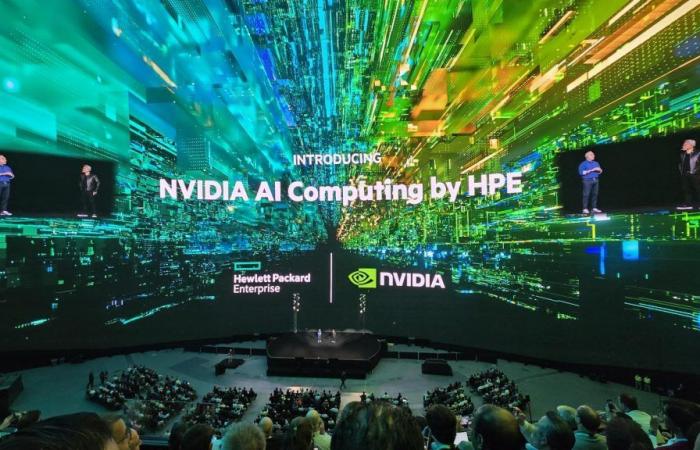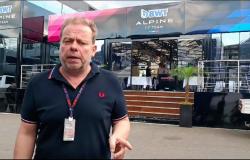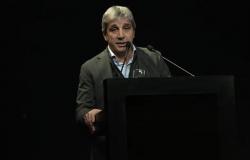I had many things to announce CEO of Hewlett Packard Enterprise, Antonio Neri, in the incredible setting of the Las Vegas Sphere. Starting with the declaration of being “the first to offer a keynote” within that construction, which has been dazzling in ‘Sin City’ for just over a year. In a city where everything is an imitation of something, the monumental Sphere is something absolutely original and inimitable.
It was as if to fear that the stage, with 5,500 open-mouthed attendees, imposed itself on the content, “stealed the show.” But Neri responds to DISRUPTORES that he didn’t even consider that: “Obviously, we did a lot of preparation work. Last year we walked to the Sphere, which was not yet inaugurated, we toured it and I told the team ‘next year, we will do Discover here’. My amazing creative team took my ideas, developed the script, the storytellingand I have felt super comfortable.”
Antonio Neri during the HPE Discover keynote in Las Vegas.
J. Miravalls
With all that, and the seats vibrating (literally), Neri revealed a cascade of news in the HPE Discover event, whose highlight is, inevitably, the emergence of generative artificial intelligence, combined with classic AI, and a first-rate strategic alliance of HPE with the, for now, great winner of AI, Nvidia. A company that Neri describes as a “visionary partner.”
The title of the new product line says it all: ‘Nvidia AI Computing by HPE‘. And the depth of the agreement between both companies is demonstrated by the stellar appearance on stage of the CEO of the GPU manufacturer himself, which in recent weeks has become the most valuable company in the world (beating Apple and Microsoft in trading).
Nvidia on stage
Jensen Huangin the flesh, clad in a black leather jacket, participated in the Neri show to establish that we are facing “the greatest transformation in computing in 60 years.”
Huang states that “each layer of computing will be new. We are in a transition, because a new industry has emerged. We once invented IT as a massive software production industry worth three trillion [tres billones, dicho en español] and now we have another extraordinary idea.”
That idea is presented by Huang as “a structure that remains invisible, but soaked in intelligence. And the work we are doing together is extraordinary – he tells Neri – to unite enterprise computing with GPUs, the cloud and the sovereignty of AI. We call that emerging industry ‘AI factories’, is producing a high volume of intelligence and our industry is being profoundly transformed. And we are only at the beginning…”
“Two years ago we didn’t even talk about this,” Neri responds. “It’s not just technology, it’s business transformation and we call it ‘the generative industrial revolution’. “It will transform business and it will transform society.”
A process that according to Huang requires “three components: the revolutionaries Generative AI language models and the data; the computing capacity to process it; and the natural resources of different countries and regions.”
They are the components on which HPE’s new proposals move, a portfolio developed jointly with Nvidia to “facilitate” generative AI for companies and that includes collaborations in software and hardware. Neri speaks of “the AI as a force for good”.
Generative AI Copilot
The joint activity of both companies integrates Nvidia’s networking and “AI software” with HPE’s storage, its intelligence computing and the “GreenLake hybrid cloud”. Neri announces his new generative AI co-pilot in OpsRamp as “a natural language interface” for operations at Green Lake.
The CEO of HPE assures DISRUPTORES that he has no doubts about this intermediation task assigned to a generative AI, despite the fact that some of the models already in service have shown some tendency to ‘hallucinations‘ (results invented randomly by AI). And Neri himself states from the stage that “innovation at any price is very dangerous.”
“As I said in the first part of my Keynote, we have five ethical principles for AI established by our HP Labs [en 2019]” Neri answers directly to our question. These points refer to establishing as priorities “safeguarding privacy [de los datos]; that is focused on the human being; that is inclusive and accessible to all; that is responsible; and that it is robust and subject to continuous quality control.” Underlines, as fundamental, the last point. QA.
The Green Lake update, which is another of the great novelties announced, integrates three features into the public cloud: a stacking to guarantee observability; the co-pilot who acts as the interface, already mentioned; and more security, through cross-monitoring of processes. Which is joined by another great announcement from HPE, which it calls “private cloud AI”.
The private cloud equipped with artificial intelligence, the product of a Nvidia-HPE joint development (“with a single control screen for everything,” Neri emphasizes) includes software that adds generative AI to its ‘observability’ tools in OpsRamp, Nvidia processing accelerators (NeMo Entreprise AI and NIM) and a new range of hardware .
The infrastructure combines Nvidia connections from its Spectrum-X range, HPE Green Lake storage and four sizes of ProLiant servers (small, medium, large and extra large) with processing support for the Nvidia GPUs L40S, H100 NVL Tensor Core and the GH200 NVL2 platform.
Private cloud virtualization
As this innovation process pulls many levers, HPE also announces agreements with large system integrators such as Deloitte, HCLTech, Infosys, TCS and Wipro, to help end customers establish, tune and maintain new applications and workflows.
“We are leading the industry,” proclaims Neri, ensuring that with the disaster recovery software from Zerto (acquired by HPE two years ago) the proposal of security and resilience of data in the private cloud is completed, to which it contributes another more announcement: the new virtualization capability.
The possibility of virtualization in the private cloud (“you had asked us for it…”, he says), along with the option of creating “bare metal containers”, plus “the supervision of Cavium, the industry standard”, makes companies They can have practically the same functionalities in their private cloud as in the public cloud. It is the embodiment of what HPE presents as the true “hybrid cloud.”
By the way, Neri sprinkles his entire speech with mentions of business use cases and takes advantage of references to Green Lake, “which connects more than four million network devices and a lot of storage in more than 34,000 businesses,” to recount HPE activities. . Especially in the sports field.
Neri first mentions that Green Lake plays a role in the “international airport connections here in Las Vegas,” before jumping to the “connections between the fans and the teams.” [deportivos] that love”. In Rome last year, she gave service to the Ryder Cup“with more than 250,000 spectators in one week, turning the golf course into a Smart city.”
In London, HPE works with Tottenham, for their relationship with fans. And another announcement from Neri: “last week we signed a sponsorship agreement to be the official cloud partner of Espai Barça”. It will provide Edge cloud and connections to Camp Nou (the day its reconstruction is completed) through Aruba Networking, an entity it bought and integrated nine years ago and offers AI-powered connections through 5G and Wi-Fi7. Green Lake, in the world of sports, seems to be an excellent seller of t-shirts and hot dogs.
And, speaking of heat, another of the points in which the CEO of HPE becomes strong is in the chapter of cooling of computer systemswith double impact on performance and energy consumption.
Liquid refrigeration
“HPE is at the forefront of applying the latest liquid technology for refrigeration, with more than two decades of experience. We have seven of the top 10 supercomputers, thanks to our leadership in liquid cooling,” says Neri, entering the field of sustainability.
“We are the case, in experience in the design, manufacture and management of liquid systems, including the infrastructure for data centers capable of the highest level of computing performance. Have hundreds of patents on liquid coolingbecause we are not only interested in having the fastest and most powerful systems on Earth.”
It is another of the event’s announcements: an agreement with Danfoss engineering to reduce the consumption of data centers and reuse excess heat that generate. The formulas proposed are scalable modularity (MDC), with racks that increase the density of processors by applying liquid cooling (they consume 20% less energy); and redistribution of excess heat to neighboring buildings and industries for various applications (can improve efficiency by up to 30%).
“There are three ways to cool [los procesadores]: with air, the traditional fans; with 70% liquid and the rest moving air; and 100% liquid, without fans” says Neri.
Talk about Apollo family supercomputers cooled exclusively with liquid, which, in addition, are much less noisy and allow heat to be reused. “There is a system in Colorado, used by the National Renewable Energy Laboratory, in which they take hot water [del circuito de enfriamiento] and redirect it through the building and parking lot. In winter it heats them without consuming gas and melts the snow. There are big storms in Colorado…”
Its new partner, the Danish Danfoss, already uses the heat of its data center in its headquarters to provide heating to nearby buildings. And Neri talks about a place in Canada where the water reheated by processors is dedicated to maintaining the temperature of greenhouses. “It is not a question of having ideas, but of producing them.”
Innovation with impact on the planet
“The future of computing is in plumbing” Neri jokes before a group of journalists, after the keynote. “You have to know chemistry, know the corrosion of materials…”.
“We guide innovation with considerable impact on the planet and for future generations. We talk about oceans, glaciers, desert sands and living things that have stories to tell,” she alleges in his grand presentation to the public, mentioning a work with the Purdue University.
Collect massive data from sounds around the world, analyzing and labeling them with AI. “The Center for Global Soundscapes has six million elements with quality datacoming from 600 different locations, occupying more than 1.2 petabytes, using HPE infrastructure, software and services,” he details.
He also talks about Australia’s supercomputing research center, which uses AI to design buoys that continuously generate electricity from ocean waves. And how AI is used in Germany to investigate the evolution of patients with dementia. “In 2020 there were 55 million people affected around the world. That number doubles every 20 years…”. He also remembers that pharmaceutical companies shared information to develop vaccines against covid, “without compromising their intellectual property.”
HPE, he explains, has developed a technique that it calls “short learning”, which trains the AI with private results. It facilitates research by hospital institutions, which keep their patients’ data private, but share the results of their analyzes with other teams, “from Osaka to Rockland, from Helsinki to Cambridge, to MIT or Stanford.”
“Creativity is intelligence having fun,” proclaims Antonio Neri, quoting Albert Einstein under the fascinating projections inside the Sphere dome.






